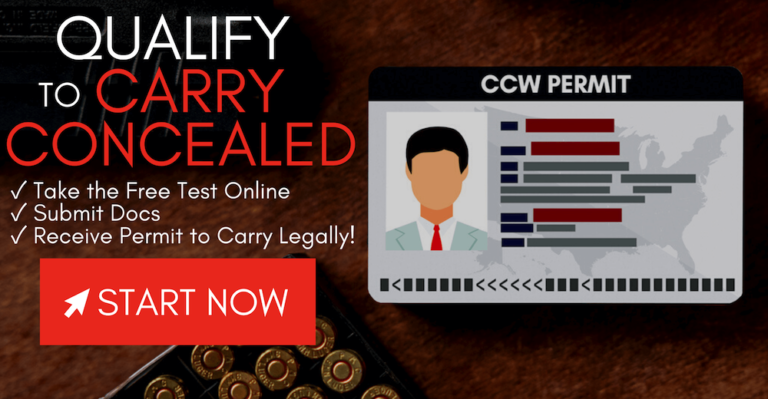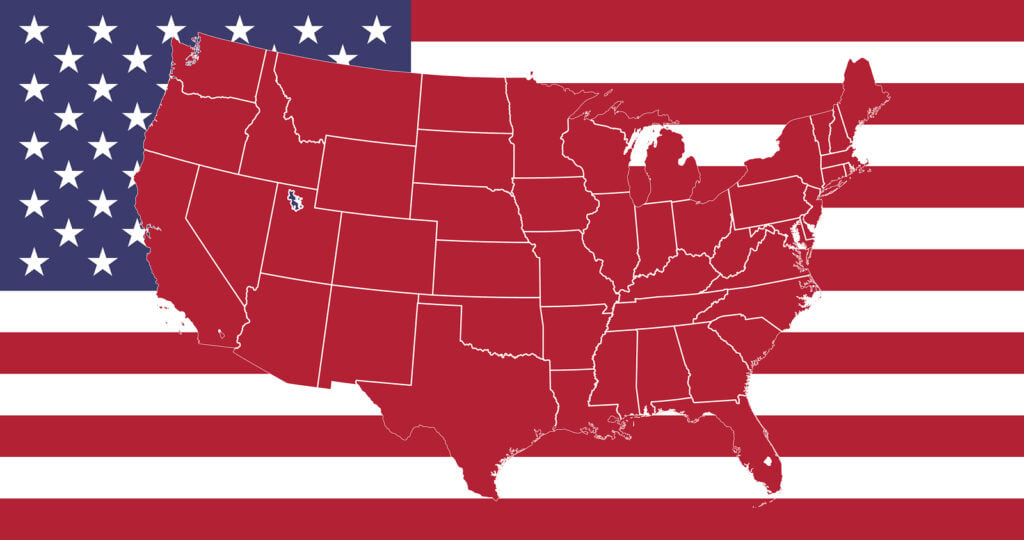Brandishing a firearm generally refers to displaying a firearm in a threatening, intimidating, or reckless manner. The exact legal definition varies by state, but most laws classify brandishing as showing or exhibiting a gun in a way that causes another person to fear for their safety.
At the federal level, 18 U.S.C. § 924(c)(4) defines “brandish” as making the presence of a firearm known to another person to intimidate them, regardless of whether the gun is visible.
For state-specific information, check your state criminal code or penal code, or visit Concealed Coalition’s Reciprocity Map for local guidance.
Understanding the Concept of Brandishing
Unlike some firearm laws that are uniform nationwide, the term “brandishing” is defined differently by each state. Despite variations, several common themes appear across jurisdictions:
- Display or Exhibition: Showing a firearm to another person, whether drawing, waving, or simply lifting a shirt to reveal a concealed weapon.
- Intent to Intimidate: The act is usually tied to threatening, coercing, or instilling fear.
- Manner of Display: Laws often use terms like “rude,” “angry,” or “threatening” to describe unlawful exhibition.
- Self-Defense Exception: Many states exempt situations where a firearm is displayed in lawful self-defense or defense of others.
- Loaded vs. Unloaded: A firearm does not need to be loaded to meet the brandishing standard in most states—the threatening display alone can trigger charges.
Federal Legal Definition
At the federal level, the definition of brandishing comes from 18 U.S.C. § 924(c)(4), which states:
“The term ‘brandish’ means, with respect to a firearm, to display all or part of the firearm, or otherwise make the presence of the firearm known to another person, in order to intimidate that person, regardless of whether the firearm is directly visible.”
Key Points:
- Intent matters more than visibility. Even if the firearm is not fully visible, making someone aware of it in a threatening context can be brandishing.
- Often tied to other crimes. Brandishing can overlap with assault, menacing, or unlawful threats.
- Federal charges are severe. A firearm brandished during the commission of a violent crime can trigger mandatory minimum prison sentences.
State Law Examples
Each state has its own penal code sections that define brandishing. Here are a few well-known statutes:
- California: Penal Code § 417 makes it a crime to draw or exhibit a firearm in a rude, angry, or threatening manner, except in lawful self-defense.
- Texas: Penal Code § 42.01 includes intentionally or knowingly displaying a firearm in a way calculated to alarm.
- Florida: Statute 790.10 prohibits improper exhibition of dangerous weapons, including firearms, in a rude or careless manner.
- Virginia: Code § 18.2-282 criminalizes pointing, holding, or brandishing a firearm in a way that induces fear in others.
Because the specific language differs widely, gun owners must review their state’s code or take state-approved training to fully understand the boundaries. (For a quick reference guide on state laws, check out our Reciprocity Maps.)
The Importance of the Legal Definition
Facing a brandishing charge can have serious consequences, both legally and personally. Criminal penalties vary by state and circumstances, ranging from misdemeanors to felonies. Beyond criminal charges, individuals may also face civil lawsuits if victims claim emotional distress or harm resulting from the incident.
A conviction often carries long-term repercussions, including the suspension or permanent loss of firearm ownership rights. For concealed carry permit holders, even being charged with brandishing—regardless of conviction—can lead to immediate permit revocation in many states.
Understanding what actions might be interpreted as brandishing is critical. Proper training not only helps you comply with the law but also ensures responsible firearm handling that protects your rights and those of others.
Common Elements Across States
Even with variations, most brandishing statutes share these elements:
| Element | What It Means |
| Display/Exhibition | Making a firearm visible, intentionally or recklessly. |
| Threat/Intimidation | The display is done to instill fear or coerce someone. |
| Manner of Conduct | Actions described as rude, angry, careless, or threatening are commonly prohibited. |
| Context | Often occurs in disputes, arguments, or confrontations. |
| Exceptions | Self-defense or defense of others may be legally protected. |
Self-Defense and Legal Exceptions
In most states, lawful self-defense serves as an exception to brandishing laws, though courts often interpret this exception narrowly.
- Permissible Example: Drawing your firearm in response to an immediate and credible threat to your safety.
- Not Permissible: Displaying your firearm during a verbal dispute where no imminent danger is present.
This legal gray area highlights the importance of scenario-based concealed carry training, like that offered by Concealed Coalition, to ensure responsible and informed decision-making.
Where to Find Authoritative Information
State Statutes and Penal Codes
Every state makes its laws accessible online, usually through official government websites or digital law libraries. By searching for terms like “firearm statutes” or “criminal code,” you can locate specific sections on assault, threats, or weapons offenses. These statutes outline both prohibited conduct and the penalties that follow.
Using your state’s official site ensures you’re reviewing the most current version of the law. Because firearm regulations vary widely between states, this step is critical to understanding how local laws will directly apply to your situation.
Federal Resources
Federal law also plays a role in defining firearms-related offenses. A key statute is 18 U.S.C. § 924(c), which addresses the federal definition and penalties for using or carrying a firearm during violent crimes or drug trafficking offenses. It provides a nationwide standard that applies regardless of state boundaries.
You don’t need a law degree to access federal resources. The U.S. Code is publicly available, and institutions like Cornell Law School’s Legal Information Institute make it easy to read and interpret these laws online in clear, searchable formats.
Case Law Databases
Understanding statutes is important, but case law shows how judges interpret and apply them. Tools like PACER (Public Access to Court Electronic Records) provide official access to federal cases, though fees may apply. For free resources, Google Scholar’s case law search is an excellent starting point.
These databases help you see how courts handle real-world disputes involving firearms. Reviewing precedent can clarify gray areas in the law and reveal how specific defenses or interpretations succeed—or fail—when challenged in court.
Legal Websites
For those who prefer plain-English explanations, legal websites are extremely useful. Platforms like Justia and Nolo summarize complex statutes into everyday language, making them easier for non-lawyers to understand. They often include FAQs, state-specific guides, and links to primary legal sources.
Law school websites also serve as valuable resources. Many compile statutes and provide commentary by state, offering deeper insights than general legal directories. These sites are especially helpful when you want both clarity and accuracy without diving directly into dense statutory text.
Attorneys
Even with online tools, laws are only half the story—their interpretation depends heavily on circumstances and precedent. That’s where consulting a local firearms attorney becomes invaluable. An experienced lawyer can explain how state and federal rules intersect in your jurisdiction.
Attorneys also stay current with rapidly changing laws and pending cases that may affect your rights. They can provide tailored advice, ensuring you don’t rely on outdated information. For anyone carrying a firearm, professional legal guidance is the most reliable safeguard.
How Concealed Coalition Supports You
At Concealed Coalition, we understand how complex firearm laws can be—especially with terms like brandishing differing across jurisdictions. That’s why we’re here to simplify the process and empower responsible gun ownership.
Here’s how we help:
- Deliver state-specific concealed carry training taught by certified instructors, tailored to your local laws and regulations.
- Provide tools like our Reciprocity Maps, allowing you to easily select your state and access up-to-date legal information.
- Focus on responsible training, teaching not only how to carry but also the critical importance of knowing when not to draw.
Ready to take the next step? Explore training opportunities to find what works best for you!
FAQs About Brandishing a Firearm
1. What is the federal definition of brandishing a firearm?
Under 18 U.S.C. § 924(c)(4), brandishing means displaying or making the presence of a firearm known to intimidate someone, whether or not the gun is visible.
2. Is brandishing always a crime?
Not always. Many states allow exceptions for lawful self-defense or defense of others, but the threat must be imminent and legitimate.
3. Can pointing an unloaded gun be considered brandishing?
Yes. In most states, the law focuses on the threatening nature of the act, not whether the firearm is loaded.
4. What’s the penalty for brandishing?
Penalties range from misdemeanors with fines to felonies with prison sentences, depending on the state and the circumstances.
5. How do brandishing laws affect concealed carry permit holders?
A brandishing conviction can result in suspension or revocation of your concealed carry permit and permanent firearm restrictions.
6. Where can I look up my state’s exact brandishing law?
Check your state’s official government website, criminal code, or penal code. Our Reciprocity Maps are a good place to start for guidance.
7. Can verbal threats count as brandishing?
In some jurisdictions, even statements implying you have a firearm can be treated as brandishing if they instill fear of imminent harm.
8. Why is training important to avoid brandishing charges?
Proper training teaches you when it is legally appropriate to draw your firearm and how to respond in high-stress situations.
Key Takeaway
While the legal definition of brandishing a firearm varies by jurisdiction, the fundamental concept is consistent: displaying a firearm in a way that intimidates, threatens, or causes fear can result in serious criminal consequences.
Being a responsible firearm owner means knowing and adhering to the laws specific to your state.
Concealed Coalition provides expert, state-specific training and education to ensure you carry with confidence while remaining fully compliant with the law.




